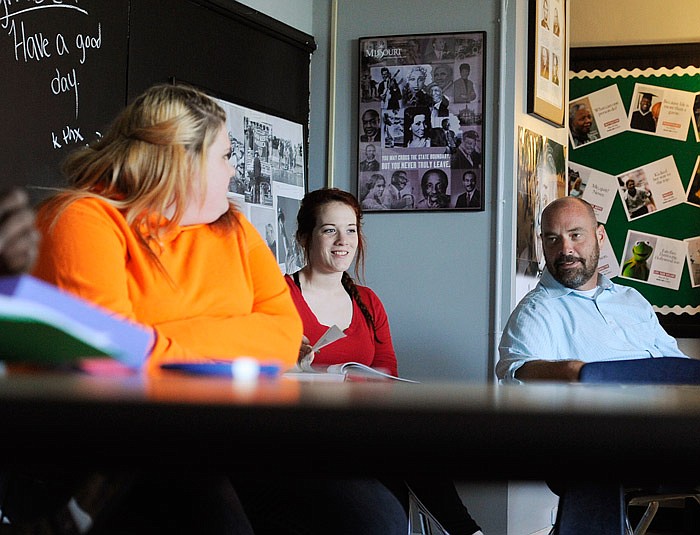People in downtown Jefferson City last week may have seen a man they assumed was homeless outside the DoubleTree Hotel.
And like almost all of the students of a local psychology class, those people probably didn't stop to ask the man if he needed any help, even as he asked for it.
Millie Dixon, a senior at Jefferson City Academic Center, was the one bystander who did finally say something to the school counselor, who was with a group of students from a couple of JCAC classes and their teachers in what turned out to be a surprise psychology class experiment.
The "homeless" man was actually Jake Hebenheimer, 18-year-old son of JCAC teacher Jay Hebenheimer, who was dressed to look the part and was in contact with his dad between the first and second time the group of students walked by him.
The first time, students said later, the man just looked drunk or high. But after his dad quietly communicated to him to act more in distress as intended, the second time around Jake was on the ground, on his stomach, seemingly in pain and verbally asking for help.
Dixon said that was what convinced her to finally say something at the last minute, when no one else had, including seven or eight adults on the street who had walked by without doing or saying anything.
"They were waiting for me to do something," Hebenheimer said in his class Thursday. His students' mental processes told them not to do anything about the situation they observed until their leader did first - the bystander effect.
Hebenheimer teaches Missouri history, world history, the American West, the American Civil War and sociology in addition to psychology. He's also head coach of boys' varsity soccer at Helias High School and head assistant coach of the girls' soccer program there.
He said he had a couple guesses as to which students in his class might help the "homeless" man in pain, but he wasn't disappointed by the general outcome of apathy. "It's a learning process," he said.
The students didn't just learn about their own behavior in the bystander experiment, though.
"You guys turned into psychologists," he told the students later after they went over to Debra Cornell's art class.
Hebenheimer's psychology class students said they and Cornell's students had a lot of internal reasons they didn't decide to act.
Nate Dickinson is a junior in Hebenheimer's Missouri history class, but he happened to be working in the teacher's room the day of the experiment and got to be a part of it. He said when he was younger and on a school field trip, he gave $5 to a homeless man but was scolded for doing that, which created hesitation.
"I knew that he needed help," sophomore Richard Stoll said, but he was unsure if the man he saw outside the hotel was dangerous.
Senior Bailey Williamson said she was concerned about whether the man could become violent and injure a classmate if she had offered help.
"I'd feel like I'd be responsible for that," she said.
The consensus was it would have been easier to act if he had instead been a woman, young child or elderly person.
Their experiment was safe and controlled; Hebenheimer gave notice to the Jefferson City Police Department, who had an unmarked car across the street monitoring the situation. He had also informed the hotel of the activity, and the hotel's marketing specialist gave cookies to the students afterwards.
The students' behaviors and rationale in the experiment are more than isolated results in a staged situation, however; bystander behaviors have had life-or-death consequences.
The class has watched some segments of the ABC program "What Would You Do?" hosted by John Quinones, which revolves around bystander experiments in public situations instigated by actors. The segment about aiding a fallen pedestrian shows real security camera footage of a homeless man who was beaten after an argument on the streets of Washington, D.C., in January 2009; he lay on the sidewalk for almost 20 minutes before an ambulance was called.
In the interim, passersby ignored the man or stopped to look before walking away. He had hit his head on the bumper of a parked minivan, and at one point, the driver even put a shopping cart next to the man on the ground and loaded groceries from the cart into the trunk.
Jose Sanchez, the man on the ground, had suffered a traumatic brain injury and bled out inside his skull for those nearly 20 minutes, according to local media reports. Blood-drowned brain cells begin to die from lack of oxygen after more than three or four minutes, meaning apparent head injury victims need immediate medical attention, according to Cleveland Clinic. Once called, an ambulance only took two minutes to reach Sanchez.
He died in the hospital three days later.
According to research described in "New York Magazine," the bystander effect of waiting for others to act first has been found to manifest in children as young as 5 years old.
It might be a natural human tendency for an individual to wait for a leader to emerge from a crowd and give a sense of permission to act rather than step up and be that leader, but that's not the only lesson Hebenheimer wanted to impart to his students through the experiment.
"There are instances in which you can be a hero," he said.

